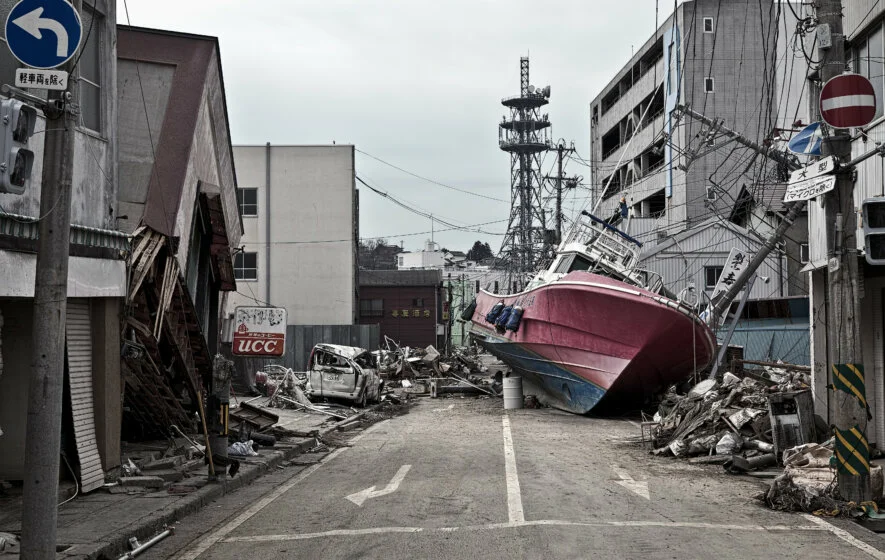Japan has the third largest economy in the world, but is almost entirely dependent on fossil fuel energy imports. In 2018, 99.7% of its oil consumption was met by imports, 97.5% of gas and 99.3% of coal.
The country is the fourth largest consumer of oil and, on an annual basis, still just ahead of China as the largest consumer of Liquified Natural Gas.
Nuclear power
To address its import dependency, Japan early on looked to nuclear power as a more indigenous means of electricity generation, its first commercial reactor coming into service in 1966. The impetus to embark on a major programme of nuclear construction was provided by the 1973 oil shock and nuclear generation grew steadily, reaching a peak in 1998 of 326 TWh.
However, Japan lies in an area of high volcanic activity formed by the meeting of the Pacific and Philippine tectonic plates and has suffered a number of extreme earthquake events.
The most recent of these was the Great East Japan earthquake and tsunami in March 2011, which resulted in the Fukushima Daiichi nuclear disaster. In its aftermath, all of Japan’s nuclear power stations were eventually closed, many permanently. From meeting 30% of the country’s energy supply in 2010, nuclear generation fell to zero by 2014.
The event prompted ongoing public debate about the future of nuclear energy in the country, given both Japan’s high level of dependency on energy imports and growing concern over the environment and thus need for low carbon energy.
By last year, only nine reactors had restarted, providing 8,706 MW of capacity sufficient to meet just 6.2% of total electricity demand.
The need to upgrade plant safety, local opposition and new requirements for anti-terrorism measures introduced in April 2019 have all slowed the restart of Japan’s nuclear reactors. In the interim, Japan has had little choice but to fall back on fossil fuels, a situation which frustrates its target of reaching a 22-24% share of renewables in its generation mix by 2030, up from 15% today.
Energy alternatives
Japan has and continues to investigate a range of alternative sources of indigenous energy, exploring technologies from hydrogen use in fuel cells, to geothermal energy, methane hydrates and more latterly wind and solar. It has some hydro-electric power, but all of the best sites have been developed.
Power generation in Japan from 2008 to 2018 in terawatt hours (TWh)
Source: BP Statistical Review of World EnergyThe country certainly took solar energy to its heart in the aftermath of Fukushima. Solar capacity has increased rapidly since 2010.
By 2018, Japan had installed 55.5 GW of solar, up from just 3.6 GW eight years earlier. Solar generated 72 TWh of electricity in Japan in 2018, or 6.8% of total electricity generation, but the expansion, underpinned by feed-in tariffs (FiTs), came at a relatively high cost and the level of support from FiTs is expected to fall in the 2020s.
Offshore wind
As a result, Japan is now looking to develop what is arguably its largest indigenous energy resource, one which could meet and surpass even nuclear’s former contribution to the country’s energy supply and support the wider low carbon electrification of the Japanese economy.
According to the International Energy Agency, Japan has sufficient offshore wind capacity to meet its total electricity needs more than nine times over based on its technical potential. Japan has 29,751 km of coastline, the seventh largest in the world.
While Japan’s seabed tends to fall steeply from its shores, the Japan Wind Power Association estimates that 91 GW of fixed-bottom turbines could be installed in Japanese waters. A study by Mitsui Global Strategic Studies Institute in 2015 came to a similar conclusion, putting the figure at 93 GW.
The country has made forays into offshore wind, but at end-2019 had only 65.6 MW of capacity installed, including semi-offshore, comprised of a collection of pilot schemes.
A key barrier to deployment, both for on and offshore wind, has been the length of time – up to five years — taken to complete Environmental Impact Assessments (EIA). Onshore wind remains constrained by land use restrictions. Moreover, for offshore wind, prefectures previously only sanctioned operation for five years, deterring large-scale projects.
Another factor impacting the development of renewables has been transmission access across Japan’s patchwork of island grids, which unusually for any country are divided into two areas nationally, which operate on different frequencies.
New law boosts prospects
However, a new law introduced in April 2019 has radically changed the investment landscape. It allows offshore wind farms to operate for 30 years, as well as designating eleven sites for development. Four areas in particular are most advanced – the sea areas offshore Noshiro City and Yurihonjo City in Akita prefecture, the area off Eno Island, Nagasaki prefecture, and, on the eastern coast off Choshi City in Chiba prefecture.
The law also provided for the first time a legal framework for the use of Japan’s ‘general waters’, which make up the majority of coastal waters. Formerly only limited areas were covered by the amended Port and Harbour Act.
Progressive gas market deregulation has also played a role, forcing generators to carry more price risk, rather than allowing them to pass price increases directly through to consumers. This has levelled the playing field for renewables.
Attracting investment
The new offshore wind law has stimulated a flood of interest in Japan’s offshore wind potential, attracting major offshore wind developers such as RWE Renewables, which in October 2019 chose Tokyo as the location to open its first Asian office. RWE Renewables is the world’s number two in terms of offshore wind development.
Japan now has a total of 13 GW of offshore wind in the pipeline, according to the Ministry of Energy, Technology and Industry. The Japan Wind Power Association says 2,916 MW of wind have started the EIA process, of which 1,398 MW are offshore.
In February, Japan’s Marubeni announced it was to start construction on the country’s first large-scale offshore wind farm, which will have capacity of 120 MW.
Moreover, auctions for new capacity in the four most advanced designated areas could take place as early as this Spring. Competitive auctions promise to deliver low prices for offshore wind as seen by the rapid reduction in costs achieved in Europe and other growing Asian offshore wind markets such as Taiwan, thereby avoiding the hefty subsidy bills experienced under the FiT scheme for solar.
While the government’s target for both on and offshore wind is 10 GW by 2030, Japan’s offshore wind industry believes that it could achieve this alone.
Given the estimations of over 90 GW of fixed-installation potential, even before the possibilities of floating offshore wind farms are explored, Japan is setting course to harness a large-scale indigenous energy source. This will not only help meet its climate change targets, but, as more nuclear reactors come back into service, put it on the road to record levels of self-sufficiency.
Photo credit: © mapo_japan, shutterstock.com

